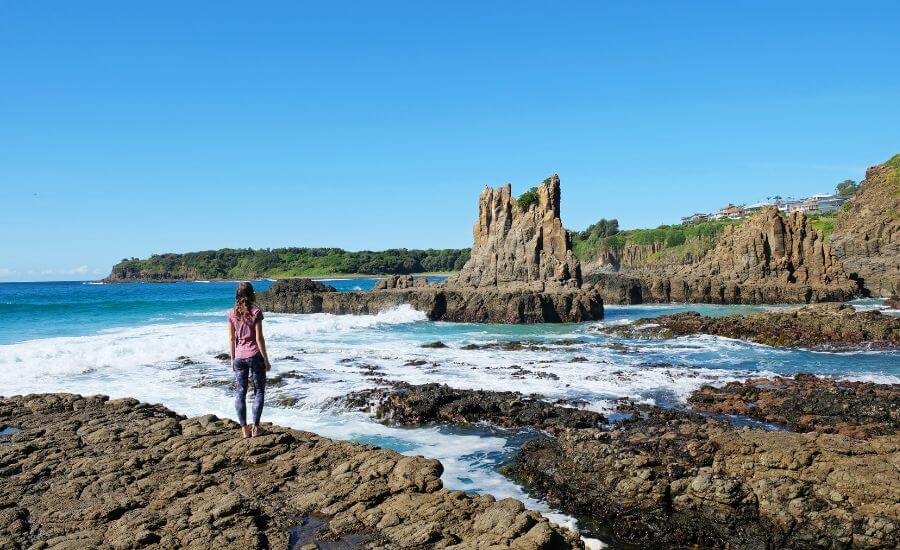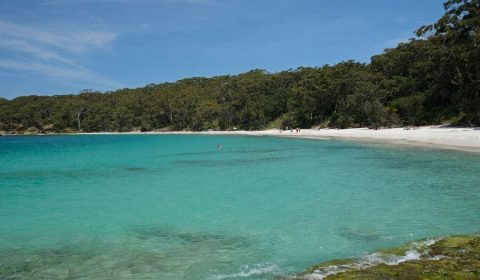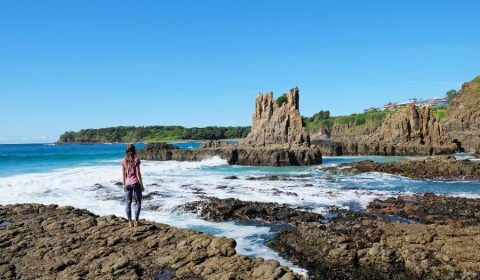Cathedral Rocks – another fascinating volcanic rock formation along the Kiama Coast Walk in New South Wales, Australia. It’s only 1.5 hours drive from Sydney, right off the M1 motorway. It’s a great addition to your road trip along Australia’s eastern coastline, but also a perfect day trip from Sydney, along with some other fabulous attractions nearby.
How to visit Cathedral Rocks? Is it safe to explore them and the surrounding area? How much time do you need? This post is your guide to visiting Cathedral Rocks, based on our own experience.
Best place to stay in Kiama:
- luxury: Terralong Terrace Apartments (apartment hotel, outdoor swimming pool)
- mid-range: Kiama Shores hotel (outdoor swimming pool, great location)
- budget: Kiama Harbour Cabins (excellent location)
What makes the Cathedral Rocks so special?
First, let’s talk about the history of Cathedral Rocks a bit. These rocks are remnants of the edge of a lava flow that has been eroded by the sea over millions of years. The columnar basalt was formed during the unique cooling process of this type of lava.
The basalt columns on this section of the coastline are quite spectacular, but the highlight is the Cathedral Rocks formation. It’s in the water and truly resembles a cathedral or castle.
Where are the Cathedral Rocks?
Cathedral Rocks is located in Kiama Downs, on the South Coast of New South Wales. Well, I should say off the coast of New South Wales since the rock formation is in the water, crashed by powerful waves. Hence you can’t actually access them, but you can get an excellent view of them from several vantage points.
How to access the Cathedral Rocks?
The best way to access Cathedral Rocks is walking there from the southern end of Jones Beach, preferably at low tide. You can park on the street or in one of the beach parking lots, then walk on the beach all the way to the southern edge.
access route marked in orange
There you’ll see the first basalt columns of the rocky headland, with a rock plateau below them. Walk on this platform, and soon you’ll stand in front of majestic Cathedral Rocks. Walk around as there are several vantage points, climb on the rocks for elevated view, and marvel at the crystal clear tidal pools.
Watch out for a small cave – if you go inside, you can see the Cathedral Rocks framed by the cave entrance. The channel here is easiest to cross at low tide.
the rocky headland at the souther edge of Jones Beach
Attempting access to Cathedral Rocks from the southern side of the headland is a common mistake, and it can get tricky. It requires some scrambling which could be difficult in large swells.
Can you access the Cathedral Rocks during high tide?
Yes, you can access the Cathedral Rocks viewpoints from Jones Beach any time. However, there are two channels cutting into the rock platforms, and crossing them can be dangerous at high tide.
The first channel is at the cave. If you don’t want to be in waist deep water, then aim to visit it at low tide. The second channel is south of it, and it’s larger and deeper. In order to cross it, you need to walk down to the small sandy beach along the rocks, then climb onto the rocks on the other side. Only attempt it at low tide, it can be treacherous when the tide is high.
But it’s worth crossing this second channel as it offers just another angle to see (and shoot) the Cathedral Rocks.
Are there any tours or guided experiences available at Cathedral Rocks?
Professional photographers use it as a workshop location from time to time, but there’s no other tours that I know of. However, you don’t really need a tour. It’s easy to locate and visit – that’s why this post is written. 🙂
What is the best time to visit the Cathedral Rocks?
The best time is when low tide is at sunrise, that’s the perfect day to visit the Cathedral Rocks. Low tide ensures safe access, and sunrise is the best time to photograph the rocks.
But other times of the day offer different light conditions which could be exciting, too. Night photography is also popular as light pollution is minimal.
Other places to visit near the Cathedral Rocks
The South Coast of New South Wales offers quite a lot to see, and you don’t even need to drive far from Kiama to visit another handful of impressive places.
Bombo Headland & the Boneyard
Bombo Headland is just south of the Cathedral Rocks, so close that you can even walk there (or drive a few minutes). A 3.8 km easy loop trail takes you around the peninsula, and it’s one of our favorite coastal walks in Australia – also one which is barely known.
The trail around Bombo Headland gives access to Boneyard Beach, a protected, pebbly bay with azure waters, great for snorkeling. But our favorite attraction is “the Boneyard”, or the Bombo Headland Quarry Geological Site.
It’s a former quarry where the volcanic cliff face is exposed, and the pretty basalt columns crashed by powerful waves are spectacular to see and photograph. It’s “Australia’s Giant’s Causeway”. There are isolated basalt columns standing right on the coast, about 5 meters in height, surrounded by lower columns.
You can walk from the south of the quarry all the way to the north, though there’s no designated walking trail. Just be careful not to slip on the rocks (wearing proper shoes help) and not to get too close to the waves (if the rocks under your feet are wet, you’re too close).
Kiama Blowhole
The name Kiama comes from the Aboriginal word kiarama, which means “place where the sea makes a noise”. And it is accurate, as the Kiama Blowhole is a rare and impressive phenomenon.
It looks like a geyser that erupts consistently, but in reality it’s an opening in the rock face on the coast from which water shoots up if conditions are met. We saw a shooting every few minutes. Some of them were smaller, some were about 10 meters high. They say it could shoot up to 30 meters if the swell is right.
You can see it from multiple viewing platforms, and nice walking trails connect it to the rest of the lovely coastal town of Kiama.
Little Blowhole of Kiama
So Kiama’s Blowhole is a rare phenomenon, but the town has two of them. Little Blowhole is on the peninsula just south of “the” Blowhole. While the latter is usually busy and very touristy, Little Blowhole gets only a tiny fraction of that attention, even though we found it just as amazing.
The small parking lot is hidden in a residential area, just off Tingira Crescent. We enjoyed the shootings almost alone the entire time we were there.
Minnamurra Lookout
It’s the first viewpoint as you start the Kiama Coast Walk on Minnamurra Headland. You can quickly reach it from either of the parking lots on a paved walkway, and it offers a great view of the Minnamurra River estuary.
There’s a whale watching platform nearby, facing the open sea, where you can spot whales between May and October. Well, if you’re lucky and have good binoculars.
More useful things to know before visiting the Cathedral Rocks
How long does it take to explore Cathedral Rocks and the surrounding area?
Allow at least an hour to walk there and look around. Enjoy the several vantage points, take pictures, have a picnic (the rocks are sharp, have a blanket).
If you visit all the other attractions in Kiama, it easily takes a full day. Yes, a great day trip from Sydney.
Can you swim or surf near the Cathedral Rocks?
Jones Beach is a good surfing beach, and there are popular surf breaks nearby – and that’s roughly everything we know about surfing, there or anywhere else. Swimming might be possible at Jones Beach, but it’s better for wading or boogie boarding as the waves are usually large.
Boneyard Beach is a bit further south, and it’s much more protected. It’s a better choice as a swimming beach, and it’s an exciting snorkeling site, too.
Are there any facilities near the Cathedral Rocks?
Jones Beach has several parking lots, picnic tables and a playground. We didn’t find any toilets though.



















